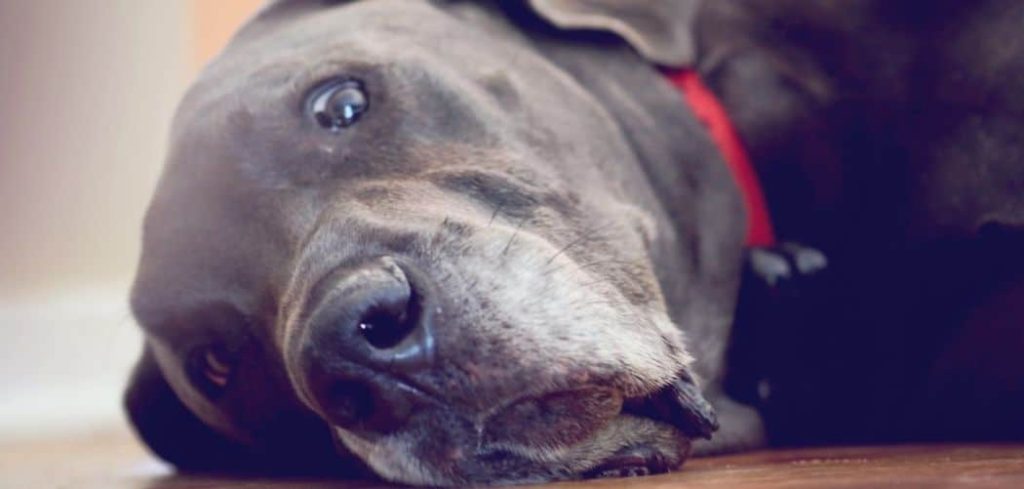When your senior dog suddenly starts stumbling, tilting their head, or struggling to stay balanced, it can be frightening.
These symptoms often point to what many call “old dog disease,” a condition more formally known as idiopathic vestibular disease.
While the sudden onset is alarming, the good news is that many dogs recover well with time and supportive care.
We outline the key facts of old dog disease, what signs to look for, and when to seek veterinary help.
Old Dog Disease
Old dog disease is most often linked to idiopathic vestibular disease, a sudden dysfunction of the vestibular system that helps control balance and coordination. In older dogs, this condition can appear without warning and mimic the signs of stroke, which is why it’s so concerning for owners.
While ear infections, inflammatory disease, toxins, or tumors can sometimes be behind vestibular symptoms, idiopathic vestibular disease is by far the most common explanation in senior dogs.
The condition tends to resolve on its own over days to weeks, though supportive care is essential.

Common Symptoms of Old Dog Disease
Loss of Balance
One of the most striking signs of vestibular disease is a sudden loss of balance. Dogs may stumble, fall over, or seem unable to walk in a straight line.
This can be terrifying for owners, as it often appears out of nowhere. The unsteadiness happens because the vestibular system, which controls equilibrium, is disrupted.
Read more: Old Dog Eyes Issues (Here’s why)
Head Tilt
A persistent head tilt is another hallmark symptom. Dogs may hold their head at a noticeable angle, sometimes to the left or right, as their body tries to compensate for the inner ear imbalance.
This tilt can last for days or even weeks after the initial episode, but in most cases, it gradually improves with time.
Rapid Eye Movements (Nystagmus)
Nystagmus, or unusual flicking eye movements, is common in dogs with vestibular disease. The eyes may dart side to side or up and down uncontrollably.
This is directly linked to the vestibular system’s dysfunction and often accompanies dizziness and nausea.
Nausea and Vomiting
Because the vestibular system is closely tied to the body’s sense of orientation, affected dogs may feel motion sickness.
Owners may notice drooling, reluctance to eat, or actual vomiting. This symptom can be especially concerning in senior dogs, as prolonged nausea can lead to dehydration and weakness.
Difficulty Standing or Walking
Some dogs may not be able to stand without falling. Others may walk in circles or collapse when attempting to move.
These dramatic mobility changes are often the first signs that send owners rushing to the vet.
Old Dog Disease Treatment
Supportive Care
Most cases of idiopathic vestibular disease improve on their own, but supportive care is key. Dogs may need help standing, walking, or even getting to their food and water bowls.
Using non-slip mats, blocking off stairs, and keeping them in a safe space reduces the risk of injury.
Medications
Vets may prescribe anti-nausea medications to ease vomiting and help dogs feel comfortable enough to eat.
In some cases, sedatives may also be given to reduce stress and disorientation. If an ear infection or another underlying cause is suspected, antibiotics or anti-inflammatories may be used.
Hydration and Nutrition
Ensuring your dog stays hydrated is crucial. Some dogs may need fluids administered at the clinic if they’re unable to drink on their own.
Offering soft, easily digestible foods can encourage eating when appetite is low.
Monitoring and Recovery
Most dogs begin to show improvement within 72 hours, with steady recovery over days to weeks.
Head tilts and mild imbalance may linger, but the majority of dogs adapt well and return to a good quality of life.
Close monitoring at home helps track progress and ensures no new symptoms develop.
Physical Support
Some owners find that slings or harnesses help dogs regain mobility during recovery. Gentle physical support during bathroom breaks or short walks can help maintain muscle strength without risking falls.
What to Do
If your dog suddenly shows signs of imbalance, head tilt, or vomiting, keeping them safe and comfortable should be your first priority.
Place them in a quiet, secure area away from stairs or sharp objects. Provide soft bedding and ensure water is easily accessible.
Some dogs may need hand-feeding or encouragement to eat small, soft meals until their nausea improves. Stay calm and reassure your pet, as your gentle presence helps reduce anxiety.
When to Call or Visit Your Vet
Any sudden onset of balance problems or disorientation in a senior dog should be evaluated by a veterinarian right away.
Because the signs of vestibular disease can mimic serious conditions such as stroke, inner ear infections, or brain tumors, a professional exam is essential.
If your dog is unable to stand, is vomiting repeatedly, or appears to be in distress, do not delay seeking veterinary help.
Even if the cause is idiopathic vestibular disease, your vet can provide medications and supportive care that make recovery much smoother.
Read more: Old Dog Peeing in House (Here’s Why)
Key Takeaway
Old dog disease, or idiopathic vestibular disease, may look frightening but is often manageable with time and care.
By recognizing the signs, keeping your pet safe and supported, and seeking veterinary guidance, you give your senior dog the best chance at a smooth recovery.
Most importantly, remember that many dogs go on to regain a happy, comfortable quality of life after an episode.
